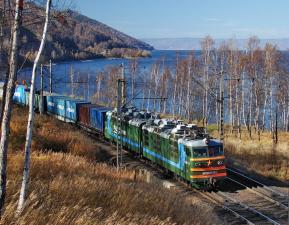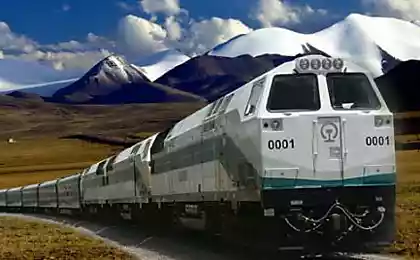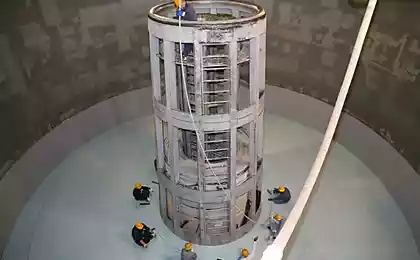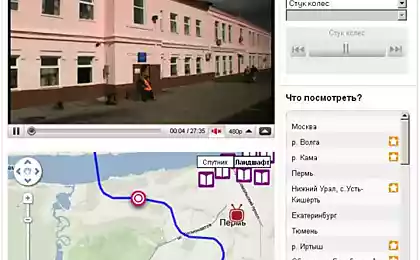1518
Trans-Siberian Railway

Trans-Siberian Railway, or as it was called before the Great Siberian Railway, the world's longest railway, linking Europe and Asia. It is a single-sheet stretched from Moscow to the Pacific port of Vladivostok for a distance of over 9,000 kilometers. The need for the construction of the railway in Siberia was aware as early as the middle of XIX century. It became clear that while there has been growth of traffic in the near future will need reliable transportation that can be used year-round.
In December 1885 it was built Yekaterinburg-Tyumen road. That was the first railway line in Siberia. The road has proven its profitability, and then the Russian government was discussing the issue of the construction of the Trans-Siberian Railway. The economic preconditions for such construction had already matured.
It was decided to start finding the shortest track within a band between 51 and 56 degrees north latitude, where geographical conditions represent the most favorable not only for the construction of a new road, but for the future development of land, mostly agricultural.
In 1886, the most loyal in the report of the Irkutsk governor-general of Count AP Ignatieff Tsar Alexander III had personally wrote: "Even as reports of governors-general of Siberia, and I read with sadness and should be ashamed to admit that the government still has done little to address the needs of the rich but neglected region. And it is time, high time ».
This resolution, and decided the fate of the Trans-Siberian Railway. After a while, followed by the command, "You must begin soon for construction of this road." The government understands that without the railway strategically Siberia, the Far East and especially the very vulnerable in the event of any conflict is unlikely to provide a defense of Vladivostok and the entire Yuzhnoussuriyskogo edge. Therefore, the Ministry of Railways quickly launched a rail investigations in Siberia. To speed up the work, it was decided to begin construction at the same time at both ends - to the west and the east.
The grand thing sulivshee Russia many benefits needed "quite exceptional, non-template implementation." And today is striking clarity and integrity of the plan, its overall completeness and harmony.
The Minister of Finance SY Witte, for example, offered to facilitate and reduce the cost of delivery of goods needed for the new road, hold the connecting railway line between Chelyabinsk and Yekaterinburg, and thus being built to link Siberian road to the center of ferrous metallurgy of the Urals. In order to strengthen economic and cultural influence of the Siberian road, Witte proposed pipeline is being built to bring the auxiliary path, equip it at the intersection of the rivers suitable ports, marinas, camps, which would contribute to the resettlement of European cultivators.
Apart from the purely organizational solutions Witte plan divides all big construction in several stages. This will effectively build a financial policy in the period of construction of the Trans-Siberian to receive income from the road.
The first phase - construction of the West Siberian region of Chelyabinsk to Obi (1332 mile), then the Central Siberian section of the Ob to Irkutsk (1734), while the construction of the Ussuri region in the Far East. The second stage involves the completion of the section from station Mysovaya on Lake Baikal to Sretensk (1032) and the continuation of the Ussuri line to Khabarovsk. Finally, the third stage - the construction of the Circum-Baikal line (312) and the section from Sretensk to Khabarovsk (about 2000).
December 10, 1892 approved the plan Witte king and then was organized by the Committee of the Siberian road. If before creation construction was carried out sporadically, mostly limited to small volumes of earthworks, largely due to the modest size of loans allocated for them, with the advent of a centralized governing body to track the situation has changed dramatically for the better.
West Siberian line from Chelyabinsk to the intersection with the Ob beginning built in 1892 under the leadership of the remarkable Russian engineer KY Michael, before that built the Samara-Zlatoust railway and Alexander bridge across the Volga.
To not only compensate for the shortage of workers, but also to be able to maneuver the labor force, the Committee decided to purchase Siberian railroad abroad excavation machines. Excavators very advanced case, as well as significantly reduced the cost of earthworks.
In general, the latest achievements of science and technology in the construction of Trans-Siberian Railway is widely used. Here is one example. Passing through the dry West Siberian Plain, builders have experienced discomfort with water supply. The water from the numerous surrounding lakes, people are not able to consume: the bitter-salty taste, very tough, it is not suitable for any practical purposes. So we had to buy special devices and chemically purify water from impurities. C
Already since October 15, 1895 opened a temporary movement across the West Siberian line. 1332 mile a little over three years! However, according ^ top Omsk railway operated ferry across the Irtysh River, AK, in March 1896 the two banks of the great Siberian rivers connected by bridge, designed by engineer and bridge-builder professor NA Belelyubsky. This bridge, like many other engineering solutions on the Trans-Siberian Railway, entered the classical textbooks. The bridge across the Ob built and opened in March 31, 1897.
Such a rapid pace of construction of railways worldwide practice is not yet known. It turned out, and they do not limit. To say so results allowed the construction of the next, Middle lines from the Ob to Irkutsk.
Lay the Central Siberian line was much more complicated from an engineering point of view: the flat terrain changed to hilly. Works on all Central Siberian site began in 1893 and were conducted from two points - from the east of the Ob and the Yenisei, too, to the east. Everywhere on the road dramatically increased the volume of excavation: approximately 2060 cubic yards a mile. But there were also very difficult mountain areas, where per mile more than 10 000 or even 21 000 cubic yards.
It was here, in the dense taiga, the builders of the first encounter with an unknown natural phenomenon engineers as permafrost. Even on a hot July, the land is not thawed, so immediately on the go, had to look for new solutions.
Industrial enterprises in European Russia clearly fulfilled orders for Trans-Siberian Railway, which - primarily in line crossings with rivers, on the Ob, the Tom, the Chulym, the Yenisei River - were specially built large warehouses. Loads though delivered in a roundabout way, but smoothly.
That prompted the need for development of the Trans-Siberian one more way to Siberia - the sea, across the Arctic Ocean. During the period of construction of Trans-Siberian Railway across the Arctic came 27 vessels with cargoes for construction. Since then began a relatively regular voyage on the Arctic routes, and in the mouths of Siberian rivers.
Let's pay attention to one important aspect - the only paved road always the shortest way. In this way, it manifested the transit nature of the Trans-purpose road was needed primarily for communication of European Russia to the Far East and the Pacific Ocean. At the side of the road was even Tobolsk - the capital of Siberia. Bends the track was not profitable for Russia as a whole!
Trans-Siberian Railway was built rapidly. October 15, 1895 went to the road Novonikolayevsk - current Novosibirsk, and on December 6 of that year, the train arrived in Krasnoyarsk, the path was extended for another 714 miles! And then the track stretched to Irkutsk. Yet more than a thousand miles of the earth deaf taiga. The chief works engineer on the Central line Mezheninov outlined in the summer of 1898 to go to Lake Baikal. And his plan fulfilled!
From Irkutsk route directly east lay not allowed Baikal. The line could pass only along the southern coast of the Siberian lake. But forbidding cliffs hanging right over the lake, it is extremely complicated and slow to build. The Committee therefore decided to bring the rails directly to the shores of the lake, and the lake organize temporary crossing that would, without reducing the pace, continue the construction of the Trans-Siberian.
From coast to coast trains had to sail to the icebreaking ferries that are specifically for this purpose were purchased abroad. Was released from the St. Petersburg team of experienced workers, shipbuilders in the open air collected in 1900, the world's largest ice-breaker "Baikal". Ferries have rendered good service. Thanks to them, too heavy a workaround on the southern shore of Lake Baikal attributed to the work of the third stage.
Work on the eastern shore of the lake, from the lake to the city Sretenskii, began in 1895. Pushechnikov engineer supervised the construction, a lot of effort and energy he devoted to Transsib, hoping to bring the pipe to the target at the appointed time - 1898.
But nature had its own way: the summer 1897 was unusually rainy, rain did not stop for days. A terrible flood struck the Trans-Baikal region. Such elements do not remember, and the old-timers. Powerful water flows completely washed away several villages that have existed for hundreds of years, rivers burst their banks. Of course, it was seriously damaged and the newly built road.
Only in 1900 the effects of floods have been completely eliminated, and the traffic on the new highway was opened. Transsiberian, thus, extending for another mile and a half in 1032.
As a result, the pace of laying Trans-Siberian Railway have decreased considerably to 685 miles a year. However, in no other country in the world where the natural and economic conditions are incomparably better, at a pace not build railways. Transsiberian paved and a half times faster than the road in America.
Yes, the Russian school of railroad builders had no equal in the world. Complex engineering problems were solved in Siberia ingeniously simple.
Starting construction of the road from two directions, builders met in December 1899 at the 346 verst by headlands around the now existing station Tolbaga.
The original plan Transbaikal line did not end in Sretensky, open up access to the Amur River, and continued on to Khabarovsk. But unexpected financial difficulties.
In 1895, the Russian government has entered into negotiations with China on the concession. It was about the construction and operation of the railway passing through the territory of China through Manchuria to Vladivostok. So there was a project of the East China Railway.
The road was built, in fact, twice. During the conflict that broke out between Russia and China in 1900, Chinese rebels destroyed almost paved road. 1,300 miles of track three quarters of Chinese were separated, it survived only about 400 miles of road. Therefore, in 1900, it had to start all over again.
In general, the East China road is already too complex engineering structures. She was 8 tunnels that pass through the mountain ranges, and several major bridges over the mountain wild rivers.
Commissioning of the East China Railway basically solved the problem of Trans-Siberian Railway. Russia had guaranteed access to the Pacific Ocean. But this did not satisfy the government, "time" line across Manchuria not allowed to talk about the full completion of the planned works.
"White spot" on the map section of the Trans-Siberian Railway remained Sretensk to Khabarovsk, as well as a small unit of around Lake Baikal. It was coming Khabarovsk railway line from Vladivostok - Ussuriysk railroad, built in 1890.
In 1899 he began laying the Circum-Baikal line - the shortest on the Trans-Siberian railway and the most difficult. There were two options bypass Lake Baikal - from the north and from the south. And the northern option though was significantly • longer, but turned out to be much cheaper than the south.
And, nevertheless, the Committee adopted the Siberian railway is the southern option. Indeed, despite the significant costs of general economic interest are constructed road would be much higher than in the implementation of the Northern variant, where the territory of more severe climate was different and did not allow to hope for a rapid settlement of her.
We had to go 312 miles, but not simple, and hewn into the rocks. Under the guidance of an engineer BU Savrimovicha in the rocks built tunnels, galleries and retaining walls. In one area only 13 kilometers in length were drilled nearly 750 miles of wells and consumed 240 tons of explosives! The longest tunnel - 363 fathoms. But all was hacked 39 tunnels! A similar road was not there, not only in Russia but also worldwide.
Finally, in 1904 - a year ahead of schedule - and the Circum-Baikal train line went. Opened continuous rail road Petersburg - Vladivostok.
A Siberian Railroad to "left" to Western Europe, to bring even more revenue to the treasury, introduced preferential fares from major European cities to Vladivostok, Tsurigi and Shanghai. And foreign passengers from that time chose a roundabout way through Siberia Sea Route. The trip by sea from London to Shanghai continued while 34-36 days, and on the Trans-Siberian Railway - only 15-16 days. Yes, and it cost almost half the price.
Demand for rail tickets grew with each passing day, and not only increased the number of passengers and cargo turnover. This forced the government to vigorously build on Transsib second way: they had to dramatically increase the capacity of the road.
The second track of the Siberian railway was not created immediately, but gradually. And by 1916, all the work is completely finished. Their completion as it gave Russia a few Transsiberian if on the Trans-Baikal railway in the beginning of the century to transport about 20 million pounds of cargo per year, after laying a second track, this figure has increased almost ten times.
Construction of the Trans-Siberian cost Russia is actually very cheap. And all thanks to the skillful organization of the construction and operation of the road. Thus, the cost of all parts of the Siberian Railway (except East China road that built the private company) amounted to 384.605 million rubles. In other words, the total length of 5678 kilometers every single mile of Transsib cost the treasury 67 737 rubles.
The press in those years wrote that the construction of the Siberian railway ranked first of all a big deal of the XX century. "Thanks to the Siberian road all Russian ports in the Far East, being on the turn, shortest, way round the world, will be called upon to play a primary role in the Pacific."























